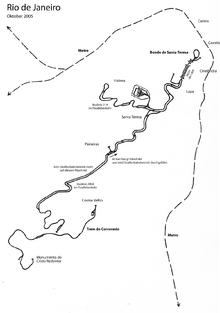Santa Teresa Tram
 Tram on cobblestone-paved section of Rua Joaquim Murtinho in 2009 | |||
| Operation | |||
|---|---|---|---|
| Locale | Santa Teresa, Rio de Janeiro, Brazil | ||
| Open | 1877; electric 1896 | ||
| Status | Open | ||
| Routes | 1 | ||
| Operator(s) | Companhia Estadual de Engenharia de Transportes e Logística | ||
| Infrastructure | |||
| Track gauge | 1,100 mm (3 ft 7 5⁄16 in) | ||
| Electrification | 600 V DC, overhead wire | ||
| Statistics | |||
| Route length | 6.0 kilometres (3.7 miles) (currently limited to 2.0 km or 1.2 mi)[1] | ||
| |||
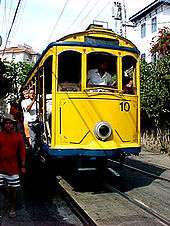
The Santa Teresa Tram (Portuguese: Bonde de Santa Teresa, IPA: [bõˈdʒi dʒi ˈsɐ̃tɐ teˈɾezɐ]) is a historic tram line in Rio de Janeiro, Brazil. It connects the city centre with the primarily residential, inner-city neighbourhood of Santa Teresa, in the hills immediately southwest of downtown. It is mainly maintained as a tourist attraction and is nowadays considered a heritage tramway system, having been designated a national historic monument in 1988.[2] The line has a very unusual gauge: 1,100 mm (3 ft 7 5⁄16 in). The main line is 6.0 kilometres (3.7 miles) long.[3]
Having run continuously since its opening in 1877 (except for a 2011–15 suspension), it is one of the oldest street railway lines in the world[2] and having been electrically powered since 1896, it is the oldest electric railway in all of Latin America.[4] It is also the only remaining metropolitan tram system in Brazil. The only other original tram systems in the country to have survived past 1971 are the Campos do Jordão interurban tram/light rail line and the Itatinga line (near Bertioga), a rural and non-public tram line,[5] which both continue to operate today.[4] All other cities closed their systems by 1971 (Santos being the last), but since that time, three towns, Belém, Campinas and Santos, have reinstated trams as heritage services, and Rio de Janeiro opened a modern light rail/tram system in 2016.
All service on the line was suspended starting in August 2011, as a result of a serious accident,[6][7] but limited service resumed in July 2015, with new tramcars. Following studies after the 2011 suspension, it was decided to buy new trams that would be replicas of the vintage previous fleet, and an order for 14 such cars was placed in early 2013.[8] Rebuilding of the line then commenced, and was continuing in late 2014, at which time reopening was projected for 2015, in time for the 2016 Summer Olympics.[9] In July 2015, limited service resumed between Estação Carioca (Carioca Station) and Largo do Curvelo,[10] and was extended from the latter point to Largo do Guimarães in December 2015, making the length of route currently in operation about 2 km (1.2 mi).[1] However, opening of the full line has been delayed to at least December 2017.[11] The current service operates from 11:00 a.m. to 4:00 p.m. (11:00 to 16:00) and no longer allows standees to ride on the running boards.
Routes

The Santa Teresa tram route rises from downtown Rio de Janeiro and follows a circuit of Santa Teresa hill, offering a high-level view of the city. It passes over the 45-metre (148 ft) high Carioca Aqueduct, a former aqueduct constructed in the 18th century[2] and 1,435 mm (4 ft 8 1⁄2 in) standard gauge electric trams used to run beneath it.[12] Except for the aqueduct, the route is shared by motor vehicles.
Before the 1960s, Rio de Janeiro trams served the entire downtown area and all near suburbs, but since 1967 only the Santa Teresa line remained. Lastly, it offered two regular services.
Regular services
Route 1 runs from near Largo da Carioca (in the central area, at 22°54′37″S 43°10′43″W / 22.910188°S 43.178732°W) to Morro Dois Irmãos ("Two Brothers hill", at 22°56′07″S 43°12′04″W / 22.935141°S 43.20109°W) and is 6.0 km (3.7 mi) long.
Route 2 runs from the same departure terminal to Largo das Neves (22°54′59″S 43°11′30″W / 22.916279°S 43.191709°W). Its length — about two-thirds of which is shared with route 1 — is 3.7 km (2.3 mi).[3]
Silvestre service
Starting in 1999 a few trips on route 1, on Saturdays only, had continued beyond Morro Dois Irmãos, to Estação Silvestre (22°56′44″S 43°12′18″W / 22.945629°S 43.204911°W), a route section previously closed in 1966.[13] However, operation of these trips became sporadic and is thought to have ceased by 2005 or 2006; the section of tramway between Dois Irmãos and Silvestre was closed definitively in 2008, after the theft of most of the overhead trolley wire.[14]
History
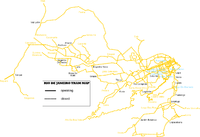
If horse-drawn tramways are included, trams have operated in Rio de Janeiro continuously since 1859. There are only four cities in the world in which trams have run longer: New Orleans (since 1835), Boston (1856), Mexico City and Philadelphia (both 1858).[15]
Rio de Janeiro's first tramway was a 7-kilometre (4.3 mi) horsecar line on which service was inaugurated on 30 January 1859 (testing began in 1858).[2] Constructed by Thomas Cochrane and operated by the Companhia de Carris de Ferro da Cidade a Tijuca, the service ran between the city centre and Tijuca. In 1862 steam trams replaced the horsecars, making the Tijuca line the first steam-powered tramway in South America, but the higher speed and poor condition of the track led to many derailments, and the line was closed in 1866.[2] It was reopened in 1870, by a different company.
A new horse-drawn tram was built in 1868 by Charles B. Greenough and a service running from Rua do Ouvidor to Largo do Machado commenced on 9 October, extended to Botafogo six weeks later. By January 1871, the line had reached Rio de Janeiro Botanical Garden, 10 km from the city centre.
Another horse-drawn tram, constructed by Albert H. Hager and run by the Rio de Janeiro Street Railway, opened on 25 November 1869. The first route ran to the palace grounds at Quinta da Boa Vista, with routes to Caju and São Cristóvão following later.
In 1870 the Rio de Janeiro Street Railway (soon to be renamed the Companhia de São Cristóvão) reopened the route of Cochrane's pioneer tramway to Tijuca. A new horse-drawn tram, constructed by João Batista Viana Drummond and run by the Companhia Ferro-Carril da Vila Isabel, opened in 1873. Further routes were opened to the Vila Isabel zoo, Engenho Novo, Méier and the suburbs along the Dom Pedro II Railroad on the northwest side of town. The Ferro-Carril de Jacarepaguá company opened a new line in 1875, running from the Dom Pedro II Railroad's Cascadura station to Taquara and Freguesia.
In name only, the Santa Teresa tramway's first horse-drawn line, operated by Empreza de Carris de Ferro de Santa Theresa, opened in the same year of 1875, but served only the flat terrain within the city centre, not actually serving any of the Santa Teresa neighbourhood (or any part of the line that survives today); it was 820 mm (2.69 ft) gauge. The same company built both a funicular (513 m long) to take passengers from the city centre up to Santa Teresa hill and a separate hilltop tram line which started at the top of the funicular. The hilltop Santa Teresa tramway, the predecessor of the current line, opened on 13 March 1877, with a gauge of 914 mm (3.0 ft).[2][16] It ran from the funicular station east to Curvelo and west to Largo do França. This main Santa Teresa line was extended from Largo do França to Silvestre in 1890. The operating company's name changed in 1885 and again in 1891, but kept the name Companhia Ferro-Carril Carioca from 1891 until the beginning of 1964.[17]
Meanwhile, steam trams were reintroduced to Rio in 1882, this time on the Tijuca line, operated by the São Cristóvão tramway company.
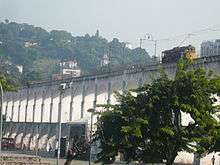
1892 saw the arrival of the first electric tram, on the Botanical Garden route. This was the first electrified street railway in all of Latin America, aside from a tram line that was extended in 1890 from Laredo, Texas, into Nuevo Laredo, Mexico (barely onto Latin American soil).[5] It was quickly followed by other electric tram lines in Rio, including a Rua do Catete service in 1894 and two new lines in Flamengo in 1896.
In 1896 electric trams replaced the horsecars on the Santa Teresa line, and the line was extended across the then-abandoned aqueduct between Santa Teresa and Santo Antonio hills (the Carioca Aqueduct), with the city terminus uniquely being built on the second floor of the company's office building on Largo da Carioca. During this rebuilding, the line's gauge was changed from 914 mm (3 ft) to 1,100 mm (3 ft 7 5⁄16 in), which it retains to the present day.[2] The Santa Teresa system's electrification was completed in 1897.
By 1897 the Carioca railway had been completely electrified, making it the first totally electric tram system in South America. Electrification expanded rapidly over the next few decades and by 1928 the last horse-drawn trams had been withdrawn from service.
From around the 1950s, the Rio de Janeiro tram system went into decline, with many lines being closed, and by the end of the decade most of the tram routes of the former São Cristóvão system had gone.
Closures continued through the 1960s, with the closure of the Alto da Boa Vista route in 1967, leaving only the Santa Teresa tram still running. The Silvestre Line had been cut back to Dois Irmãos in 1966;[3] the section beyond was abandoned following storm damage.[13]
The Santa Teresa tram moved to its new modern terminal in 1975, in the gardens of the Petrobrás oil company, located on the roof of the company's parking garage. This was the Santa Teresa line's sixth successive city-centre terminus; it remains the system's terminal today.[2] The system is currently operated by the Companhia Estadual de Engenharia de Transportes e Logística.[4]
Depots and terminals
During the heyday of the Rio de Janeiro tram system, there were a number depots (carhouses) and terminals.
Depots at Cascadura, Penha, Méier, Alto da Boa Vista, Usina, Triagem, 28 de Setembro, Vila Isabel, São Cristóvão, Bonjardim, Rua Larga, Santo Antonio (neighbourhood), Largo do Machado, Largo dos Leoes and Cosme Velho are all now closed, and the only depot still operating is Santa Teresa itself.
Most termini are also now closed, including Freguesia (Jacarepaguá), Taquara, Madureira, Irajá, Cavalcante, Inahauma, Caxambi, Piedade, Quintino Bocaiúva, Caju, Andarai, Santa Alexandrina, Estrela, Praia Vermelha, Leme, Gávea and Silvestre. Lastly, three termini have still been served, near Largo da Carioca, at Dois Irmãos and Largo de Neves, and of these Largo da Carioca is the only one with a terminal (building).
One historic mule tram depot, at Vila Guaraní, is preserved.
Problems
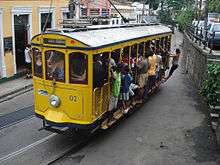
Prior to the 2011 suspension, the tram's fleet was outdated, with only five cars remaining in use on a regular basis, which were almost a century old. The cars were open-sided with wooden cross-benches, leading to street children often hopping on and off for free rides. Electricity to the cars is provided through roof-mounted trolley poles, and all cars are bi-directional. The old cars were built locally by the tramway companies, but several key components were supplied by foreign manufacturers: traction motors from English Electric, controllers from General Electric and trucks by the Peckham Manufacturing Company (Kingston, New York).[2] The cars and tracks were not in good repair, so the ride was slow and bumpy, though the carriages were regularly repainted in keeping with the tram's heritage image. The ride is good for sightseeing, but besides tourists, there are few regular paying passengers and so the tramway was increasingly running at a loss. The new replica trams under construction, which began to arrive in 2014, have new safety features, but retain the appearance of the old cars, for heritage-preservation value and tourist appeal. They are bi-directional, open-sided cars, using trolley poles to collect current.
Suspension and renovation

.jpg)
Six people were killed and at least 50 injured when a tram derailed in late August 2011.[18] All service was suspended indefinitely after the accident.[6]
The year 2013 saw the start of a R$110m project for the procurement of new rolling stock and the renovation of the tram line.[19] An order for 14 new two-axle trams was placed with a Brazilian manufacturer named T'Trans (based in Três Rios).[8] Delivery was originally projected to begin in November 2013,[8] but was delayed, and the first car was not delivered until August 2014.[9] Reopening of the line is planned to take place in stages, starting with the section between Largo da Carioca and Largo do Curvelo, followed by the section up to Praça Odylo Costa and lastly by the section to Estação Silvestre. At the end of May 2014, it was predicted that service on the first stretch would be reinstated in August 2014,[20] but this was delayed, and only one new tramcar had been delivered by 1 October 2014 and was making test runs.[9]
After additional delays, the first segment finally reopened on 27 July 2015, with very limited service initially, covering only the 1.7-kilometre (1.1 mi) section from Carioca terminus to Largo do Curvelo and running only between 11:00 a.m. and 4:00 p.m., every 20 minutes, Monday to Saturday.[21] Service was extended from Largo do Curvelo to Largo do Guimarães on 28 December 2015, but without any expansion to the limited hours of operation.[1] During the 2016 Summer Olympics, the hours of operation were temporarily expanded, to 8:00 a.m. to 4:00 p.m., and the frequency was doubled, to every 10 minutes.[22]
The old trams are in storage at the depot (carhouse), their fate undecided,[21] and the new trams that have been delivered so far are stored in the Carioca terminal loop.[1] Reconstruction work on other sections of the line continued in 2015,[10] but has been temporarily suspended since April 2016, and reopening of the full line is now not projected to be achieved until December 2017.[11]
See also
- Rio de Janeiro Metro
- Supervia - Rio de Janeiro suburban railway
References
- 1 2 3 4 Tramways & Urban Transit magazine, March 2016, p. 110. LRTA Publishing (UK)
- 1 2 3 4 5 6 7 8 9 Morrison, Allen (1989). The Tramways of Brazil: A 130-Year Survey. New York: Bonde Press. pp. 17, 90–113. ISBN 0-9622348-1-8.
- 1 2 3 Claydon, G. B.; and Mather, G. (August 1977). "South American Tramways Today / Part 2: Rio de Janeiro". Modern Tramway and Light Rapid Transit magazine (UK), pp. 271–279. Ian Allan Publishing. ISSN 0309-8222.
- 1 2 3 Morrison, Allen (1 November 2010; later updates). "The Tramways of Latin America in 2015". Retrieved 2015-11-28.
- 1 2 Morrison, Allen (1996). Latin America by Streetcar: A Pictorial Survey of Urban Rail Transport South of the U.S.A. New York: Bonde Press. pp. 3–5. ISBN 0-9622348-3-4.
- 1 2 "Five die in Rio de Janeiro tram derailment". BBC News. 27 August 2011. Retrieved 24 May 2013.
- ↑ Phillips, Dom (23 May 2015). "‘Olympic Park’ viral video satirizes failing Rio infrastructure". The Washington Post. Retrieved 17 June 2016.
- 1 2 3 Tramways & Urban Transit magazine, May 2013, p. 195. LRTA Publishing (UK).
- 1 2 3 "Bondinho de Santa Teresa passa por testes" [Testing of the Santa Teresa tramway is a saga without end]. O Dia (in Portuguese). Rio de Janeiro. 29 September 2014. Retrieved 2014-10-01.
- 1 2 "Bondes de Santa Teresa recebem 2 mil passageiros no sábado" [Santa Teresa tram carries 2,000 passengers on Saturday]. G1 (Rede Globo). Grupo Globo. 1 August 2015. Retrieved 2015-11-29.
- 1 2 "Obra no bonde de Santa Teresa deve ser concluída em dezembro de 2017. Reforma começou há cinco anos. Moradores reclamam de transtorno em meio a tapumes e trânsito na região" [Work on the Santa Teresa tramway should be completed in December 2017. Reconstruction began five years ago. Residents complain of disorder amid sidings and traffic in the area]. O Dia (in Portuguese). Rio de Janeiro. 14 July 2016. Retrieved 2016-08-14.
- ↑ The Aqueduct. Allen Morrison. 1998. Retrieved 2010-11-15.
- 1 2 Morrison, Allen (1999). "Silvestre charter, 1996". Retrieved 15 November 2010.
- ↑ Tramways & Urban Transit magazine, July 2008, p. 271. LRTA Publishing (UK).
- ↑ Morrison, Allen (1989). The Tramways of Brazil: A 130-Year Survey, p. 23. Bonde Press. ISBN 0-9622348-1-8.
- ↑ The Santa Teresa Tramway. Allen Morrison. 1998. Retrieved 2010-11-15.
- ↑ Morrison, Allen (2014). "Santa Teresa Tramway: Vehicles, 1875–present". Retrieved 29 November 2015.
- ↑ "Bondes de Santa Teresa voltam a funcionar em junho de 2014". 8 November 2013. Retrieved 14 June 2014.
- ↑ "Santa Teresa terá bondes de volta em 2014, diz governo". Editora Abril S.A. 8 November 2013. Retrieved 29 November 2015.
- ↑ "Novo bonde de Santa Teresa entra em fase de testes na fábrica". Empresa Brasil de Comuicaçao. 28 May 2014. Retrieved 14 June 2014.
- 1 2 Tramways & Urban Transit magazine, October 2015, p. 413. LRTA Publishing (UK)
- ↑ "Bondes de Santa Teresa, Rio, operam em horário ampliado na Olimpíada" [Santa Teresa trams, Rio, operate in extended hours during the Olympics]. G1 (Rede Globo). Grupo Globo. 2 August 2016. Retrieved 2016-08-14.
External links
| Wikimedia Commons has media related to Santa Teresa Tramway. |
- 1998 Map of Santa Teresa Tramway by Allen Morrison
- 2010 Map of Santa Teresa Tramway and Corcovado rack railway by Allen Morrison
- Previous condition of Largo da Carioca tram terminus
- History of Rio de Janeiro tramway – The Rio de Janeiro chapter from The Tramways of Brazil (1989)
